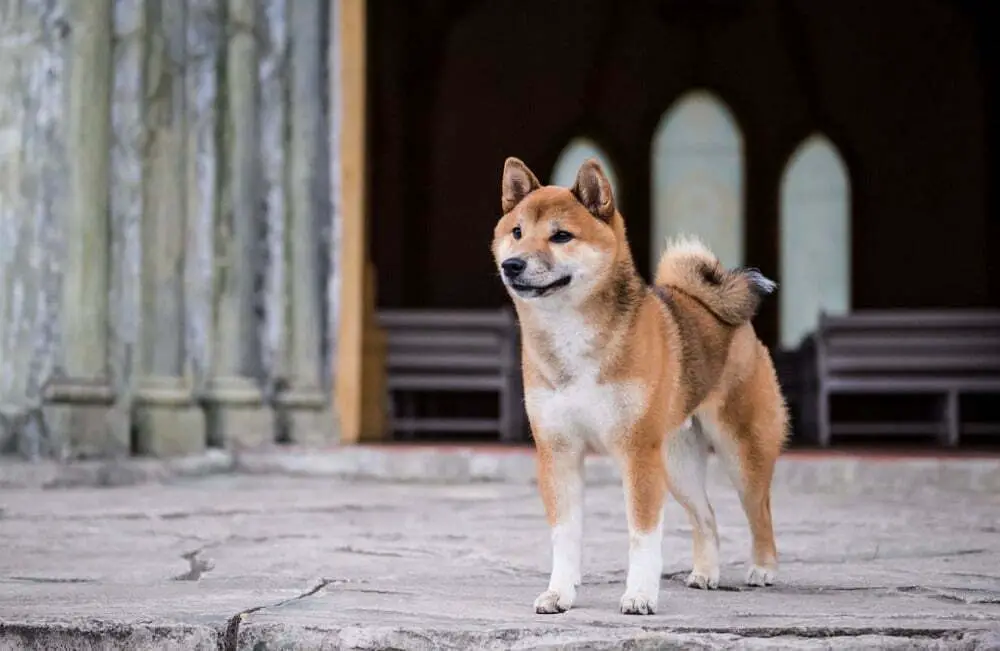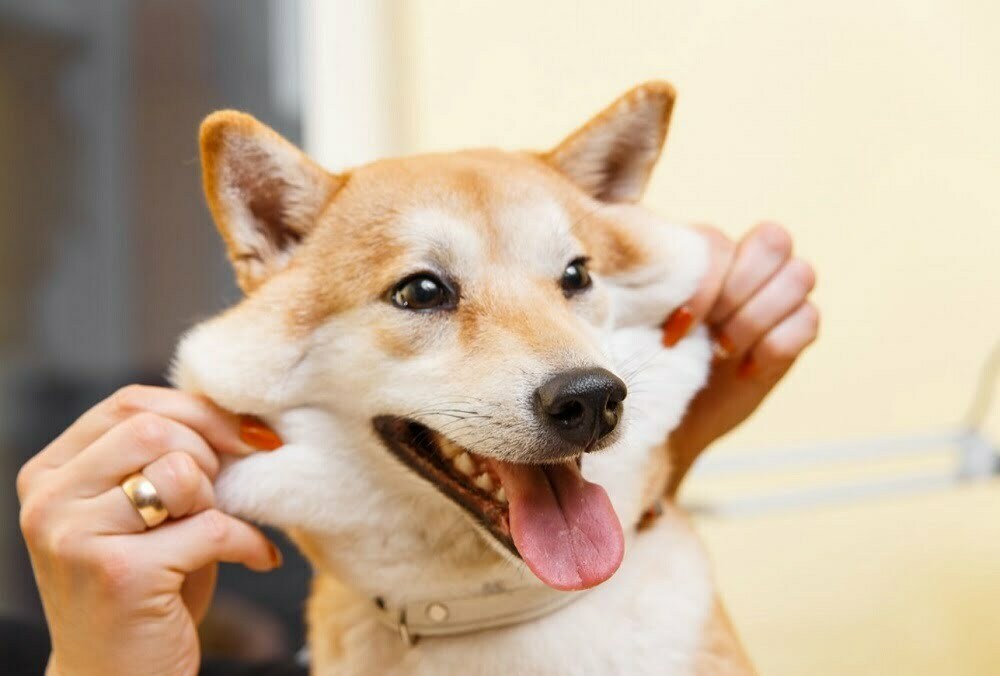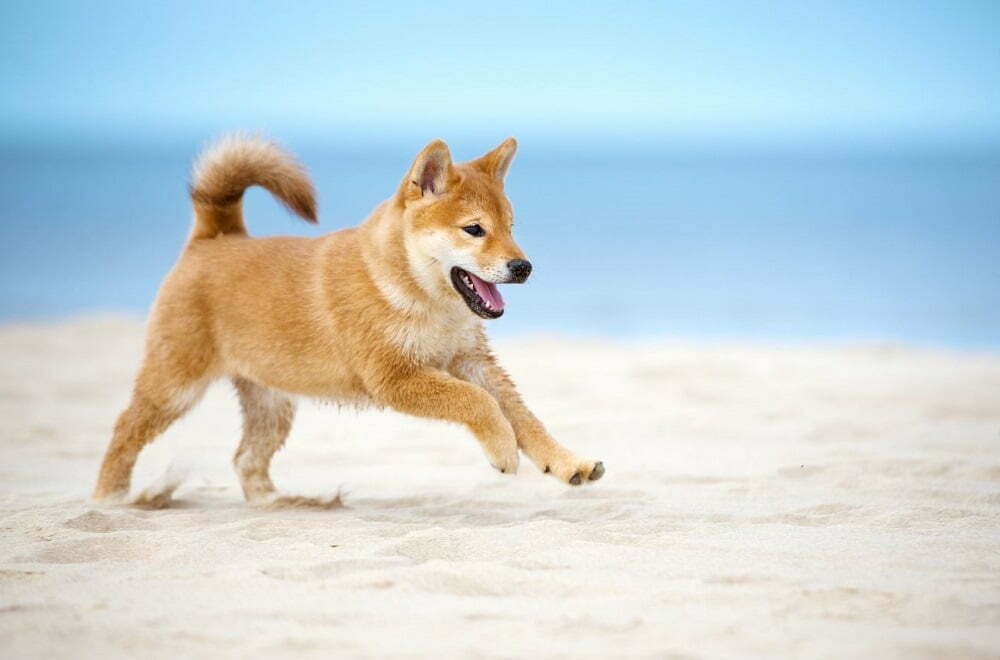Shiba Inus are gorgeous small dogs that look very similar to a fox. Before going out to buy one, here are some essential pieces of information you should know.
Key facts
Average lifespan
You can expect a healthy Shiba Inu to live for between 12 and 16 years. The longest living Shiba Inu recorded lived to a whopping 26! This is only 3 years shy of the oldest dog ever recorded. The dog in question was called Pusuke and died in December 2011.
Minimum exercise (per day)
Shiba Inus are a fairly energetic breed. They will need daily exercise at a minimum. It is recommended that they have 40 to 60 minutes of exercise with plenty of time off of the lead when you are both confident.
It is a good idea to allow your Shiba Inu plenty of outdoor time in your garden during the day. This will prevent them from becoming bored and give them a chance to release some excess energy. You must make sure that you have a high and secure fence around your garden as they will seek out weak spots and escape.
When your Shiba Inu is a puppy, its exercise requirement is reduced. Their growing joints and bones are fairly fragile, and you should take care to ensure they do not injure themselves.
Coat length
This breed has a relatively short to medium-length coat. The fur is quite coarse and consists of a thick undercoat and an outer coat over the top. The overcoat measures between 1 and 1 ¼ inches long
Minimum cost (per month)
According to dog experts, the first year of a dog’s life tends to be the most costly. The figure tends to average out at about $3,625 for the first year, or about $320 per month.
It is estimated that for the rest of their life, the annual costs will drop to $1,080, provided there are no severe health issues. This equates to about $90 a month.
Appearance
Size
This is a small dog breed.
Average height
The average height varies according to the dog’s gender. Males should measure between 15.5 and 16.5 inches, whereas females are between 14.4 and 15.2 inches. These measurements are taken at the withers, the highest point of the shoulder blades.
Average weight
The males will weigh between 17.6 and 24.3 pounds. The females are often slightly smaller. Their weights tend to fall between 14.9 and 19.8 pounds.
Temperament
Apartment living
This small dog is the perfect breed for an apartment setting. They are energetic but not too destructive. They will be fine living in an apartment if you exercise them sufficiently.
Good for novice owners
Shiba Inus are very kind dogs, making them a great choice for novice dog owners.
Sensitivity level
They are not a massively sensitive breed.
Tolerates being alone
This breed can handle being alone for a moderate amount of time.
Tolerates cold weather
Shiba Inus can tolerate cold weather quite well. This is primarily due to their thick undercoat which provides them with a lot of insulation.
Tolerates hot weather
Shiba Inus are better in colder weather conditions than hot ones but will be okay.
Affectionate with family
This very loyal and loving breed will thrive in a family setting. To ensure this setting is familiar, it is important to socialize them consistently while they are young.
Kid-friendly
This is a sociable breed, and Shiba Inus tend to get on well with children. It is important to teach children to be gentle and kind to their dogs to ensure no accidents happen. Even the most good-natured of us snap when provoked.
We advise telling children to leave their dogs alone while they are eating and sleeping. They should never be taking the dog’s food away while eating, and we strongly recommend supervising interactions between the kids and the dog.
Dog friendly
This is not a dog that likes to share with others. Shiba Inus can become quite territorial and have been known to guard their food, toys, and living space aggressively from other dogs. They are known to chase after smaller animals as they consider them to be prey.
Socialization will again help to make your Shiba Inu more friendly to other dogs. If you are wary about their behavior, we advise keeping them on a leash around other animals.
Friendly towards strangers
Shiba Inus are known to be a little wary of strangers, to begin with. Once they have built a bond, they are all over you, though!
Health and grooming

Shedding
Shiba Inus are known to shed twice a year heavily. The extent to which they shed seems to vary between dogs, with some owners claiming each shed lasts 6 months.
Drooling
Shiba Inus do not drool a lot, as far as dogs go. If this stringy saliva substance has you running for the bathroom, a Shiba Inu is a safe bet.
Grooming
As most Shiba Inus have a relatively short coat, you do not need to worry about grooming them very frequently. We recommend once per week to assist with removing dead hair and distributing natural oils through the coat. It is advised to groom them daily during shedding periods, as this reduces the quantity of fur you will find around your home.
It is a good idea to bathe your Shiba Inu infrequently too. This helps to keep them odor-free. It should not be done too often as this can dry out their coats and skin. Once every 3-4 months should suffice.
We advise cleaning your dog’s teeth daily. If you cannot manage this, 2 or 3 times a week will be okay. This helps to remove the buildup of tartar, reduce bad breath, and prevent gum disease.
You should trim your Shiba Inu’s nails 1 or 2 times per month. Some dogs will wear them down naturally, but you should keep an eye on them. If you can hear the nails clicking on the floor, they need to be trimmed. If they grow too long, it can become painful for your dog.
General health
This breed is considered to be generally relatively healthy. Aside from the care mentioned above, you should check their ears weekly for signs of redness. This suggests an infection, particularly if coupled with a bad smell. Use a cotton ball dampened with a pH-balanced ear cleaner to wipe out the inside and keep them clean. Do not go into the ear canal, as this can be painful for your dog.
Keep an eye out for rashes, sores, tenderness, redness, or inflammation as you groom your dog. These suggest health issues or infections. Check there is no discharge running from their eyes too.
Common health problems
Common health issues for Shiba Inus include cataracts, entropion, and glaucoma. They are prone to joint issues such as hip dysplasia and luxating patellas. They are also prone to developing allergies.
Cataracts are when the transparent lens inside the eye begins to cloud over. These clouds expand over time, causing the vision to become blurry. If left untreated, this condition will lead to blindness.
Entropion is a condition where the eyelid inverts, forcing the eyelashes to rub against the eyeball. This is incredibly irritating and uncomfortable. It is commonly the lower lash line that inverts, although the top one can as well.
Glaucoma is a condition affecting the optic nerve – the neural pathway from the eyeball to the brain. It is commonly caused by a buildup of fluid in the forefront of the eye, increasing the pressure. As with cataracts, this is a treatable condition but must be caught early to prevent blindness.
Hip joints are made of what is known as a ball and socket. This refers to the pelvic bone and the top of the thigh bone. Hip dysplasia is the term for when the ball is not fully covered by the socket, meaning that it dislocates more frequently. This is not commonly a condition that comes on later in life, as most dogs with hip dysplasia are born like that.
Luxating patellas are more commonly known by the term trick knee. It is when the kneecap frequently dislocates, which can cause issues with mobility. This is a common condition in small dogs and will often become evident by the time they are 6 months old.
Allergies in Shiba Inus commonly present as atopy – a skin allergy. This is often in response to pollen, dust, and mold. They are also fairly susceptible to becoming obese, which can exacerbate a lot of other pre-existing health conditions. As with all dogs, Shiba Inus are prone to parasitic, bacterial, and viral infections.
Shiba Inus are susceptible to dental problems such as gum disease. This may not seem serious, but it can reduce their lifespan by up to 3 years.
It is recommended that you clean your dog’s teeth regularly. You should also take them for periodic joint examinations at your veterinarian’s office. Their eyes should be tested yearly.
Potential for weight gain
As with many other dog breeds, Shiba Inus are prone to obesity and weight gain. The iconic viral images of fat Shiba Inus are adorable, but this is not fair to the dog. Their tiny bodies are already prone to hip dysplasia and excess weight only makes this more likely to happen.
It is important to research the appropriate diet and exercise information for this breed before you welcome one into your home. Obesity can lead to respiratory issues, osteoarthritis, diabetes mellitus, tumors, and lethargy.
Trainability
Easy to train
Shiba Inus are fiercely independent dogs and can be a handful to train. Experts say that Shiba Inus should never be considered reliable when letting off the lead unless they are in a confined area. This will not change no matter how many obedience classes they attend. They are escape artists and will make a run for it, often never to be seen again.
They are very easy to train to pee outdoors as they are born with housebroken instincts. By the time they are a month old, they instinctively move away from their sleeping area to eliminate their waste. Most Shiba Inus can control themselves all night by the age of 5 weeks. If you are hot on opening the door every time it looks like they need to pee, they will be house trained in no time.
Intelligence
Shiba Inus are a very intelligent breed, but this comes with a fair amount of stubbornness too. This can make them a challenge to train, but you will get there eventually. The trick is to make them think that it is their idea to be obedient.
They are very fast learners and are very eager to please.
Potential to bite
As with any dog, Shiba Inus have the potential to bite when provoked. They are not particularly aggressive dogs and with proper training, biting should not be an issue.
Tendency to bark or howl
This is a moderately loud breed of dog. They do not bark a lot, but they are known to make a noise known as the Shiba scream. This sound is fairly unique to them and is commonly made when they are unhappy about something going on near them.
History

These dogs are the oldest and smallest breed to come from Japan. The word Shiba in Japanese translates to brushwood, and Inu means dog. It is believed that their name comes from the terrain that is native to and the location where they like to hunt. Some people believe that they were named after brushwood as their fur is a similar color to the autumnal leaves of brushwood bushes.
These dogs were bred for hunting and their main role was to force birds and other small game out of bushes for the hunters to kill. They are highly effective at this and were used for this purpose for many years.
Representations of Shiba Inus have been seen in artwork made in the Jōmon period in Japan, between 14,000 and 300 BCE. During the time of the Meiji Restoration in 1868, it became common to cross-breed classical Japanese dogs with imported ones. This meant that in the early 20th century there were very few purebred Shiba Inus living. By 1928 efforts had begun to preserve the purebred Shiba Inus, but this was not overwhelmingly successful.
During the Second World War, many Shiba Inus were killed as a result of bomb raids. A lot more died following this as a result of a highly contagious virus known as distemper. Following this, many Shiba Inus were brought into cities from the rural countryside and many breeding programs were set up to boost their population once again. As numbers started to grow, the breeding programs continued and the Shiba population began to stabilize once more.
The Japanese Kennel Club was started in 1948 and they quickly adopted a Shiba Inu breed standard, as set out by Nihon Ken Hozonkai.
By 1954, the first Shiba Inu had been brought over to the United States. There is little other information surrounding the introduction of Shiba Inus to the western world until the mid-1970s. In 1979 the first litter of Shiba Inus was born on American soil. By 1993, the breed was officially recognized in the American Kennel Club Miscellaneous Class. In 1997, they were finally granted full status with the Non-Sporting Group.
Costs
Shiba Inus are not a cheap dog to purchase. The initial cost of a puppy will likely cost you in the region of $1,400 and $3,500.
You will need to budget approximately $500 per year for basic supplies such as leashes, collars, dog bowls, and harnesses. Add in a further $250 to $700 for food and treats annually. Grooming supplies such as dental care, brushes, ear cleaners, shampoo, conditioner, and nail clippers will set you back around $300-500 per year.
Factor in a further $100 to $400 for bedding, crates, and toys. Finally, medical expenses can range from $330 to $725 per year depending on their general health level.
Fun facts
- The Japanese government began keeping records of Japanese dog breeds in the 7th century to preserve Japan’s cultural heritage. Shiba Inus were one of the first recorded breeds.
- Shiba Inus are more closely genetically related to wolves and ancient dogs than modern dog breeds such as German Shepherds and Labradors.
- When your dog sheds its undercoat, it is also called blowing its coat.
- When Shiba Inus are happy, you will notice their ears flattening to their head and a goofy smile appearing across their face.
- Shiba Inus are one of the most popular dog breeds across Japan and have been declared as a national treasure of the country.
- There used to be 3 different kinds of Shibas – Mino, Sanin, and the Shinshu. These are named after their native regions in Japan.
